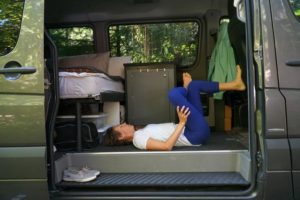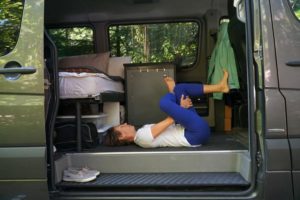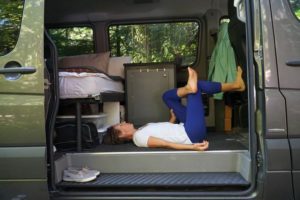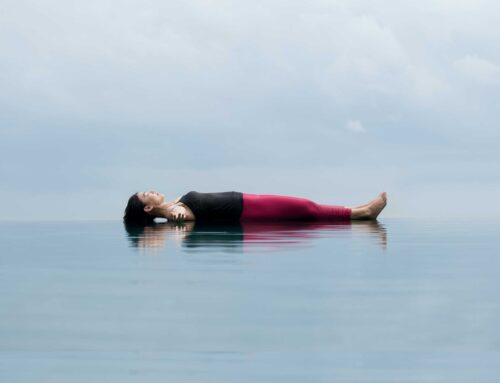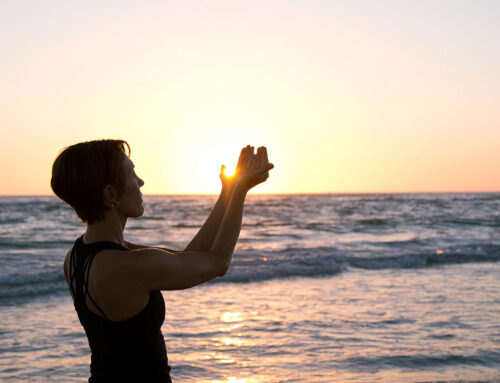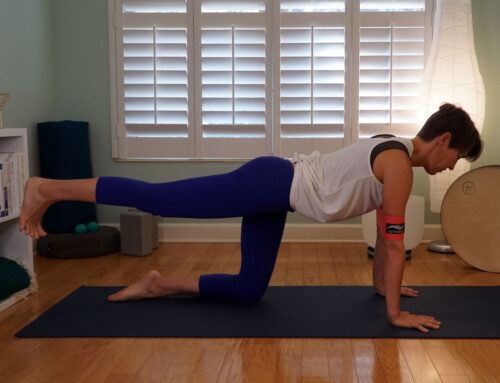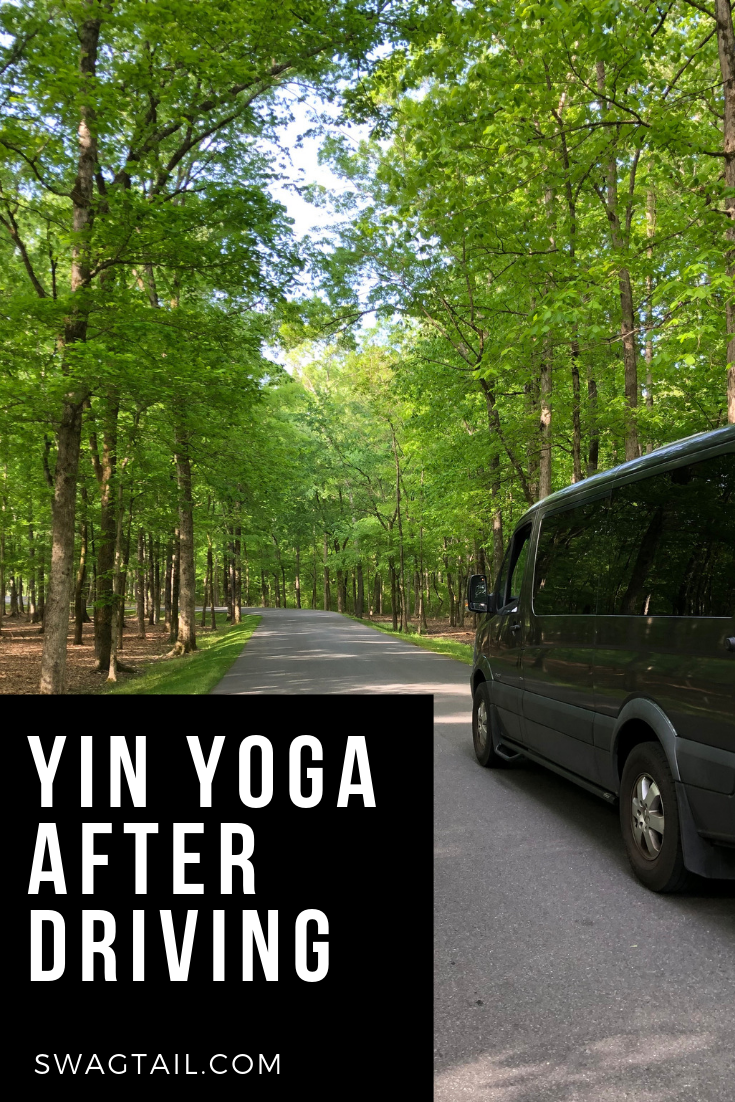 Driving a vehicle, whether around town to teach clients or on a long summer road trip, can provide immense freedom in your life. Yet hours on the road can also cause unwanted patterns to develop in the body’s fascia and muscular tissue. That’s why I use this yin yoga sequence after driving. Within minutes, mental fatigue and internal stress will wash away. And you’ll be ready to face the next class or adventure with a fresh perspective.
Driving a vehicle, whether around town to teach clients or on a long summer road trip, can provide immense freedom in your life. Yet hours on the road can also cause unwanted patterns to develop in the body’s fascia and muscular tissue. That’s why I use this yin yoga sequence after driving. Within minutes, mental fatigue and internal stress will wash away. And you’ll be ready to face the next class or adventure with a fresh perspective.
This is a sequence I’ve been using a lot on the road lately. The scenery of the Pacific Northwest is stunning! The highways weave between dense, green forests. You catch glimpses of Mount Rainier and Mount Baker towering into the skyline on sunny days. And, in the backcountry, rushing streams indicate you’re heading in the right direction.
The only problem is that I get carsick on such roads and I’ve been doing almost all the driving for two weeks straight. This yin yoga sequence after driving is what I use in the afternoons to offset the hours seated. It opens the hip flexors and heart. The hamstrings, hips, and spine get some love, too! Most importantly, I feel grounded when I’m done.
It’s with this clear headspace I can warmly embrace what’s next. While this sequence is also designed to accommodate my small van space, you can easily spread out on your mat at home or on any hard surface! I hope you enjoy it as much as I do—wherever you’re practicing today!
SEQUENCE TIPS
Just to be clear, this yin yoga sequence after driving can be used in several ways. You can share it with your own clients who spend hours commuting to and from work each day. These postures can also be used by you after driving around town for clients and classes. Or, if you find yourself adventuring out on the open highway, this sequence can unwind tension after long drives. Use your imagination and have fun with it! Just make sure you stay at 50-70% of your max stretch in each posture. This will give your body permission to relax more deeply as you progress.
Length of time: 30 – 60 minutes, depending on how long you hold each posture.
Suggested Props:
- 2 blocks
- A strap
- A bolster
- An eye pillow (optional)
(1) CHILD’S POSE
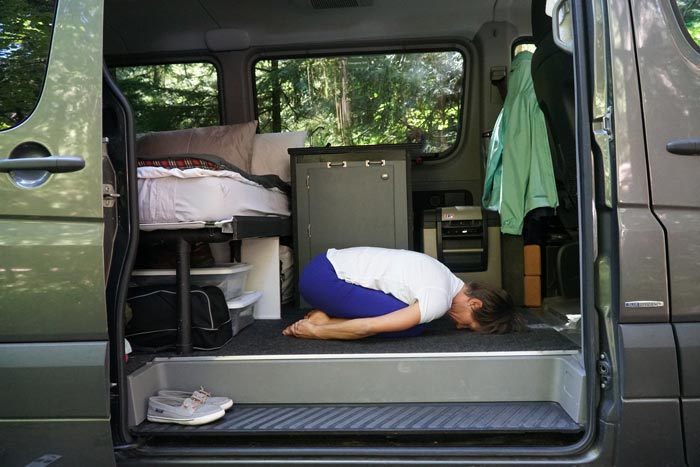
Purpose: Put your forehead on the ground and let the thoughts of the day melt into your mat. In addition to releasing mental tension, this posture can alleviate low back strain.
Length: 2 minutes
Additional Notes:
- Place a block under your forehead to give you more breathing space.
- Use a bolster under the entire torso for a heightened sensation of being still and grounded. Then, turn your head to one side for the first minute. Then switch halfway through.
(2) INTENSE TOE STRETCH

Purpose: Your feet work hard for you each day. And did you know that your big toes need 40 degrees of extension to help you walk properly? Well, this pose will help lengthen the entire sole of the foot and place the toes into extension. It’s a great way to offset the tension that accumulates in the feet after being shoved into shoes for hours on end (and then pressing the gas and brake pedals while driving).
Length: 2 minutes
Additional notes:
- To make this posture easier, you can lean forward to take the weight off the soles of the feet.
- I like to add eagle arms during this posture to help make the time go more quickly and also get a nice stretch between the shoulder blades. If you choose this route, just switch which arm is on top at the halfway point.
(3) VIPARITA KARANI
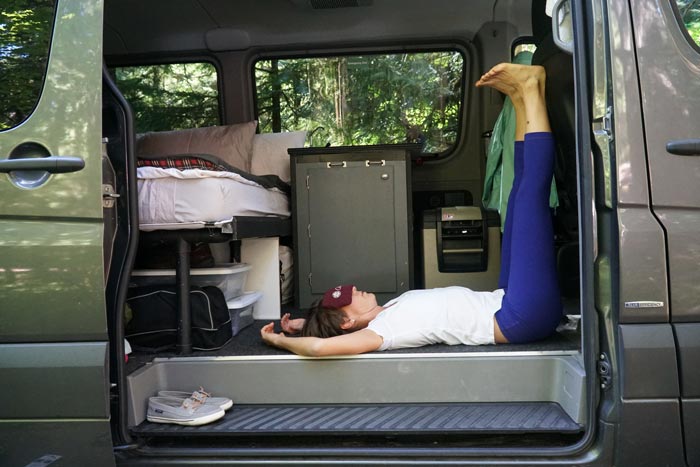
Purpose: The body works hard to pump the blood from your feet back to your heart all day long. This inverts that process. With your legs elevated, gravity helps blood return to your heart. This posture also starts to lengthen the hamstrings, relax the calves, and release the low back.
Length: 3-5 minutes
Additional notes:
- You can loop the strap at the mid-calf level and tighten that loop to keep the legs in a static position. This should make it even easier to hold the legs up the wall.
- You can also place the bolster under your pelvis to invert even more.
Counterpose: Hug the knees into the chest, and rock side to side gently.
(4) RECLINED FIGURE 4
Purpose: Strength in the outer hips is also important for your body’s ability to walk, climb stairs, and move in many directions. Sitting for long hours can cause this region to go dormant. Thus, this yin yoga sequence after driving heightens your awareness in the hips. And, when you pair it with some postures to engage the hip stabilizers (like warrior 2, ardha chandrasana, or even bird dog with the back leg out to the side), you’ll discover more balance in this area.
Length: 3-5 minutes each side
Additional notes:
- You can alter your distance from the wall to change the intensity of the stretch. The closer to the wall you become, the more intense the stretch will be. I suggest starting further away for the first minute or two. Then, if you want to work deeper, adjust accordingly.
- You can use your hand to prop up your bent leg, and continually move the quadricep away from the torso (as that leg externally rotates).
- Keep the foot on the bent knee flexed. This will help protect the knee.
Counterpose: Rest with both legs up the wall for 30 seconds to one minute between sides.
(5) SUPTA PADANGUSTASANA

Purpose: This posture will continue down the path of lengthening the hamstrings and glutes again. One leg at a time will receive these benefits since the strap will only be around one foot. This will occur whether the other leg—the one without the loop—is bent or straight. However, since this is a yin yoga sequence after driving, the hip flexors do get tight. You can extend the bottom leg to start to initiate this stretch (while the back side of the body is working on the other leg).
Length: 3-5 minutes each side
Additional notes:
- Reach your arms as far up the strap as you can, while still leaving the back of your shoulders on the ground. This will allow your upper arm bones to become a weight that counters your hamstring stretch in the vertical leg.
- Bend the knee on the vertical leg to make the stretch easier.
- Bend the knee, and place the foot on the floor of the non-strapped leg to lessen the stretch, too.
- You can also target the outer hamstring specifically for the last minute by moving the top leg across the midline of the body 20-40 degrees.
Counterpose: The core often gets weakened with hours of driving. Throw in a minute of core work here to offset the stillness of this sequence and strengthen your midsection.
(6) SUPTA BADDHA KONASANA
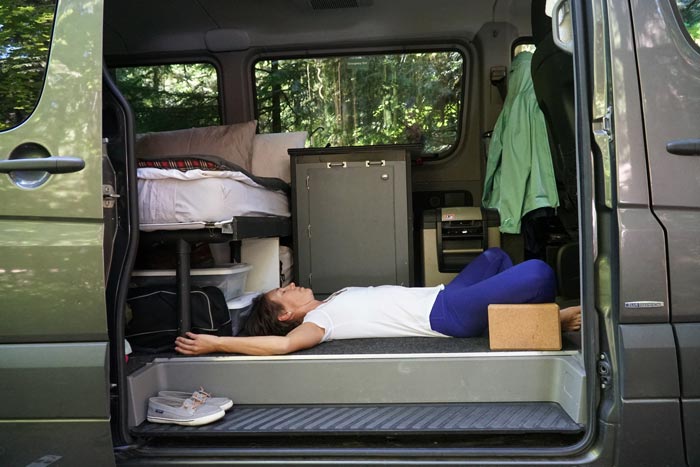
Purpose: Now that you’ve created some freedom in the back of the body and outer hips, it’s time to tune into the inner thighs. Reclined bound angle is just the pose to keep you on the ground and on your back.
Length: 3-5 minutes
Additional notes:
- Place blocks under each bent leg for more support.
- You can also place the bolster behind your back, starting at the lowest rib, to create more traction in the low back. If you take this route, might I suggest a pillow under the head and neck?
(7) SUPTA VIRASANA

Purpose: After working around the hips from the back to the outer and then the inner, it’s time to address the hip flexors on the frontside. This pose naturally lengthens the quads and abdomen. It’s also a great way to open the heart and release the tibialis anterior (the front of the lower leg that allows you to lift your foot on and off the pedals of your car when driving).
Length: 3-7 minutes
Additional notes:
- If your sitting bones don’t reach the floor, prop them up with a block and/or blankets.
- Make sure you add as much height behind your back as necessary to make the posture comfortable. You don’t want any strain on your low back. So, to make that happen, you might have to use a bolster as well as some blankets.
Counterpose: Sit upright in virasana for one minute to neutralize the spine. Then, if you want to take a down dog or dolphin for a more active rest pose for another minute, do so before moving on.
(8) DEER POSE

Purpose: Now that the spine is long and the hips are refreshed, we’ll combine both elements into this delicious twist—deer pose. Just make sure your knees are at 90-degree angles, with the front shin parallel to the long side of your mat and the back shin parallel to the short edge.
Length: 3-5 minutes each side
Additional Notes:
- To focus more on the hips first, you can keep your arms extended and your spine more upright. Then, when you are ready to add in the spinal elements, fold more forward.
- If you don’t have a bolster for your torso, you can rest on forearms. Or, you can even stack your blocks for support.
- You might to add more height, and lessen the twist, by adding the bolster on top of the blocks. That’s okay, too!
(9) SAVASANA

Purpose: This time in stillness will allow you to integrate the changes in the body and mind from your yin yoga practice. If you have space to sprawl out, do so. If you want to dive more deeply into the parasympathetic nervous system, you can always take a second round of viparita karani (3) one more time for your final resting pose. Just make sure you are comfortable and supported. Breathe naturally and feel your entire body supported by the surface beneath you.
Length: 3-10 minutes
Additional Notes:
- Again, an eye pillow here can be a nice way to remind the eyes to soften after driving.
- If you want to sit for meditation after this practice, then find a comfortable seat after a few minutes in a supine position.
PUTTING IT TOGETHER
Life on the road can take its toll on the body and mind. Even yoga professionals aren’t immune from the changes that occur in the body after hours behind the wheel. That’s why you can use this yin yoga sequence after driving for your own benefit. Or, pass it on to your clients who also log lots of time in their vehicle. If you’re like me and spend months at a time in a van, this sequence will restore all aspects of your being while away from home!
Take Action Now:
- Try this sequence out yourself this week.
- Check out our other yoga sequences to make class planning easier in the future.
- Email me with suggestions about the types of sequences you want to see on this website.


